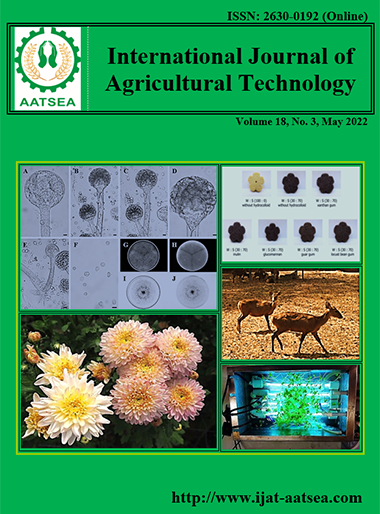Study of biochar on growth and yield of Choy Sum (Brassica chinensis L.var parachinensis)
Main Article Content
Abstract
The effect of biochar on the growth and yield of choy sum was investigated at harvesting time for 7 weeks after sowing in a pot experiment. The effect of biochar on the growth and yield of vegetables and the effects of biochar on the physiochemical properties of the soil were recorded. The results revealed that using wood biochar at the ratio of 4 t h −1 significantly increased height, width leaves, number of leaves, chlorophyll content, fresh and dry weight of the plant compared to the control treatment. In term of soil properties, biochar application in soil increased soil pH, while electrical conductivity (EC) was not altered. Thus, addition biochar to the soil can be one of the best practices to overcome any biotic stress in soil and increased the crop productivity
Article Details

This work is licensed under a Creative Commons Attribution-NonCommercial-NoDerivatives 4.0 International License.
References
Ainatul, A. A., Zainab, H., Othman, H., Zakaria, W., Lee, B. B. and Noorulnajwa, D. Y. (2012) Int Conf., ST-P21: Characterization of physiochemical properties of biochar from different agricultural residues (Malaysia: MICOTribe), 1-9.
Biederman, L. A. and Harpole, W. S. (2013). Biochar and its effects on plant productivity and nutrient cycling: a meta-analysis. GCB Bioenergy, 5:202-214.
Carter, S., Shackley, S., Sohi, S., Boun Suy T. and Haefele, S. (2013). The Impact of Biochar Application on Soil Properties and Plant Growth of Pot Grown Lettuce (Lactuca sativa) and Cabbage (Brassica chinensis). Agronomy, 3:404-418.
Chan, K. Y., Van Zwieten, L., Meszaros, I., Downie, A. and Joseph, S. (2007). Agronomic values of greenwaste biochar as a soil amendment. Australian Journal of Soil Research, 45:629-634.
Crombie, K., Masek, O., Cross, A. and Sohi, S. (2015). Biochar—synergies and trade-offs between soil enhancing properties and C sequestration potential. GCB Bioenergy, 7: 1161– 1175.
Gaskin, J. W., Speir, R. A., Harris, K., Das, K. C., Lee, R. D., Morris, L. A. and Fisher, D. S. (2010). Effect of peanut hull and pine chip biochar on soil nutrients, corn nutrient status, and yield. Agronomy Journal, 102:623-633.
Hossain, M. K., Strezov, V., Chan, K. Y. and Nelson, P. F. (2010). Agronomic properties of wastewater sludge biochar and bioavailability of metals in production of cherry tomato (Lycopersicon esculentum). Chemosphere, 78:1167-1171.
Jaafar, N. M., Clode, P. L. and Abbott, L. K. (2014). Microscopy observations of habitable space in biochar for colonization by fungal hyphae from soil. Journal of Integrative Agriculture, 13:483-490.
Jeffery, S., Verheijen, F. G. A., van der Velde M. and Bastos, A. C. (2011). A quantitative review of the effects of biochar application to soils on crop productivity using meta-analysis. Agriculture, Ecosystems and Environment, 144:175-187.
Laird, D. A., Fleming, P., Davis, D. D., Horton, R., Wang, B. Q. and Karlen, D. L. (2010). Impact of biochar amendments on the quality of a typical Midwestern agricultural soil. Geoderma, 158:443-449.
Lehmann, J. (2007). Bio-energy in the black. Frontiers in Ecology and the Environment, 5:381-387.
Lehmann, J. and Joseph, S. (2015). Biochar for environmental management: An introduction. In Biochar for Environmental Management: Science, Technology and Implementation, by Johannes Lehmann and Stephen Joseph. Routledge.
Lehmann, J., da Silva, JP Jr., Steiner, C., Nehls, T., Zech, W. and Glaser, B. (2003). Nutrient availability and leaching in an archaeological anthrosol and a ferrasol of the Central Amazon basin: Fertilizer, manure, and charcoal amendments. Plant and Soil, 249:343-357.
Major, J., Rondon, M., Molina, D., Riha, SJ. and Lehmann. J. (2010). Maize yield and nutrition during 4 years after biochar application to a Colombian savanna oxisol. Plant Soil, 333:117-128.
Mengel, K. and Kirkby, E. A. (2001). Principles of Plant Nutrition. 5th edition. KluwerAcademic Publishers, Dordrecht.
Mikan, C. J. and Abrams, M. D. (1995). Altered forest composition and soil properties of historic charcoal hearths in southeastern Pennsylvania. Canadian Journal of Forest Research, 25:687-696.
Mukherjee, A. and Lal, R. (2013). Biochar impacts on soil physical properties and greenhouse gas emissions. Agronomy, 3:313-339.
Rondon, M., Lehmann, J., Ramírez, J. and Hurtado, M. (2007). Biological nitrogen fixation by common beans (Phaseolus vulgaris L.) increases with bio-char additions. Biology and Fertility of Soils, 43:699-708.
Singh, P. B., Hatton, J. B., Singh, B., Cowie, L. A., Kathuria, A. (2010). Influence of biochars on nitrous oxide emission and nitrogen leaching from two contrasting soils. Journal of Environmental Quality, 39:1224-1235.
Steiner, C., Wenceslau, G. T., Lehmann, J., Thomas N., Vasconcelos de Macêdo. J.L., Winfried E. H. Blum, and Wolfgang. Z. (2007). Long term eVects of manure, charcoal and mineral fertilization on crop production and fertility on a highly weathered Central Amazonian upland soil. Plant and Soil, 291:275-290.
Yu, X. Y., Ying, G. G., Kookana, R. S. (2009). Reduced plant uptake of pesticides with biochar additions to soil. Chemosphere, 76:665-671.
Yuan, J. and Xu, R. (2011). The amelioration effects of low temperature biochar generated from nine crop residues on an acidic Ultisol. Soil Use Manage, 27:110-115.
Yuan, J., Xu, R. and Zhang, H. (2011a). The forms of alkalis in the biochar produced from crop residues at different temperatures. Bioresource Technology, 102:3488-3497.
Yuan, J., Xu, R., Qian, W. and Wang, R. (2011b). Comparison of the ameliorating effects on an acidic ultisol between four crop straws and their biochars. J. Soil. Sediment, 11:741-750.
Zhang, W., J. Niu, V. L. Morales, X. Chen, A. G. Hay, J. Lehmann and T. S. Steenhuis. (2010). Transport and retention of biochar particles in porous media: Effect of pH, ionic strength, and particle size. Ecohydrology, 3:497-508


